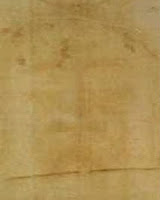shroud replica inside the cathedral
I certainly don't need a burial cloth or a history book for that matter to believe Jesus lived and died for me and for the world. He is not bound by books, by time or by our limited ways of thinking. But after hearing and seeing all the evidence to support the authenticity of the Holy Shroud, there is little room for doubt of it's genuineness.
I encourage everyone to do your own research on the this religious relic. The historic and scientific details are fascinating and difficult to ignore. Long before the latest findings an Agnostic professor remarked "Had the image on the shroud been that of anyone other than Jesus Christ, the sheer weight of evidence that we have seen would cause it's authenticity to be widely accepted."
The evidence I found most interesting was the qualities of the shroud that are unable to be reproduced. There is overwhelming agreement that the image was not painted or hand created. There are no traces of paint or other creative materials that would suggest it was drawn or designed by man. When photographed and viewed as a photo negative it has convincing naturalistic lights and darks. Long before the age of photography the shroud contained these hidden properties leading us to believe that this is the first photograph of Jesus Christ. Not only that but through more in depth scientific investigation, the image on the shroud has special 3D properties that can be appreciated with advanced technology.
photo negative of the shroud
depiction of Jesus Christ based off the image on the shroud
the shroud's 3D properties
the shroud with both the front and back images of His body head to toe
close up of His head and face
close up of His hands and wounded wrists
It is also worth mentioning a seemingly insignificant fact that I found interesting which is that the blood collected from the shroud was tested and found to be the blood type AB which is a universal receiver but can only donate to others with the AB blood type. When thought of in a spiritual context it is more significant because Christ accepts all of us, but only gives salvation to those who accept Him and share the Holy Spirit.
Other interesting details include the rare herringbone cloth it is made of which points to it's distinct origin in history. This as well as small plant pollen found on the cloth trace it back to Israel where it must have been if it were authentic. Initial carbon dating has since been proven to be invalid because scientist used an end piece of the cloth which was undoubtedly contaminated by the countless times it was handled each time it was publicly displayed. It was quickly labeled a fake based on this alone. But a more critical look at the evidence and new research emphasize its validity. There is still much controversy over this, but the nature of the image and how it was fixed on the cloth remains a mysterious phenomenon which is likely why it is one of the most studied artifacts in human history.
What is also notable is how the shroud has managed to survive all this time. It narrowly survived through two major fires creating thirty-two holes in the cloth but leaving the vital image intact. It has also managed to survive floods, earthquakes, sieges, religious persecutions, vandalism all of which and more the cloth somehow survived.
But by far the most compelling details are found within the cloth itself. The hidden, and somewhat unexplainable properties of the shroud provoke deep consideration. Dead bodies do not leave imprints of themselves. And it can't be explained by direct contact of sweat and blood because science proves again and again that it only makes sense that something was flashed over a distance to create the contours that make up what we see as a photograph centuries before photography was even invented. It's as though it is a snapshot of Jesus Himself, coming back to life during the moment of His resurrection.
Perhaps the shroud gives us the same opportunity afforded to Doubting Thomas. Who declared he would not believe Christ had risen from the dead until he could put his fingers in His wounds. Then Jesus told him, "Because you have seen me, you have believed; blessed are those who have not seen and yet have believed." (John 20:29) It's possible that the shroud brings us face to face with the same decision each of us must make individually. Whether or not to believe.
If you're ever in Torino, Italy I definitely recommend you check out the museum. I would go on a weekday when there are less visitors like we did. We had a personal tour with detailed explanations from a man who had been there for over 30 years. Very insightful. It is impossible for me to cover all of the facts and details in a single blog post. I encourage you to seek more information on the topic for yourself. I got the official DVD entitled Shroud - Passio Christi Passio Hominis which is directed by Academy Award winning director, David Rolfe. It delivers a visual and informative look at the history and authenticity of the shroud and is offered in 6 different languages. It can be found online for those who may not have the opportunity to visit the museum. However, the museum has several things not mentioned in the film and are best experienced in person. I'll probably share more of our trip to Italy along with photos in a separate post later in the week.








No comments:
Post a Comment